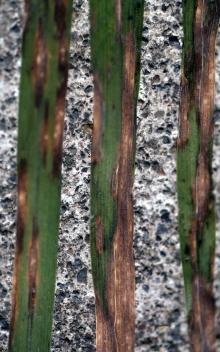Cause At least two species of Rhynchosporium scald fungi. Rhynchosporium orthosporum infects bentgrass, fescue, orchardgrass, ryegrass, and bluegrass; R. secalis is best known as the cause of scald in barley, but it can also infect bentgrass and ryegrass. Rhynchosporium scald is one of the more common causes of leaf spot on orchardgrass, perennial ryegrass, and tall fescue in winter and spring. Now it also is known to cause head blight in orchardgrass, which, in the early 1980s, Selenophoma fungi were thought to cause. Head infection by the scald pathogen is less common in other grass seed crops than in orchardgrass. All orchardgrass varieties are susceptible, but early ones are subject to more damage.
The pathogen survives as dormant mycelia in living plants or plant debris. Scald fungi sporulate profusely in wet conditions, releasing conidia that are splashed or blown to uninfected tissue. Prolonged cool (55°F to 65°F), wet, cloudy spring weather favors the disease. Only a day or two of moisture is needed for the conidia to germinate. New mycelia then infect the plant and produce more conidia. Symptoms do not appear for 10 to 14 days after infection. Rainy weather into May favors head blight in orchardgrass.
Symptoms Early symptoms include small water-soaked lesions with irregular margins. Lesions enlarge and coalesce to form irregular shaped blotches with defined margins. Color of the blotches varies with grass host and may include light brown, grayish brown, or reddish-brown. Leaves often die from the tip downward.
Head blight in orchardgrass after heading, lesions appear on the stem and panicle that are pale brown with dark borders. Lesions girdle the panicle branches and often are intermixed with healthy green areas, producing a "barber pole" effect.
Cultural control
- Field burning has little effect on this disease, but practices that delay heading and reduce lodging may help.
Chemical control The key to reducing damage in orchardgrass is to prevent infection of the flag leaf and head. Once scald lesions are on the panicle, it is too late to control the disease, and yields will drop. Apply a fungicide at least once to orchardgrass seed fields at boot stage or very early head emergence, even if weather has been relatively dry. In a rainy spring apply twice: first at boot stage, then at early head emergence. Applications at flowering are less effective.
- Bravo Ultrex (Group M5) at 0.9 to 1.4 lb /A. One (1) or two (2) well-timed applications of Bravo are more cost-effective than three (3). There has been no advantage to tank-mixes of Bravo and Tilt unless rust is also a problem. Do not apply within 14 days of harvest. Do not allow livestock to graze treated fields. 12-hr reentry.


